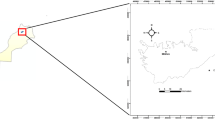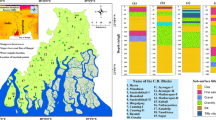Abstract
One of the appropriate ways to prevent groundwater contamination is identifying the vulnerable areas of the aquifers. The DRASTIC framework, for assessing the intrinsic vulnerability of the aquifer, is a common method which uses a specific parameter’s weight and a uniform distributed contaminant in overall the aquifer. Therefore, it should be calibrated for specific aquifer and contaminant distribution conditions. In this research, random forest (RF) and genetic algorithm (GA) methods were used for DRASTIC framework optimization in Miandoab plain (NW of Iran). In optimizing the basic DRASTIC framework (BDF) using GA, decision variables are the weight of DRASTIC parameters and weight values for each data layer are the outputs of the optimization. The final optimized map (BDF-GA map) was obtained using overlaying the layers with optimized weights based on the GA method. In optimization of BDF using RF, the model is made up of from 1 to 100 trees and the m parameter or split variables was optimized by changing the number of variables between one and the maximum variables of each subset. Also, the feature selection method is used to reduce the dimensions and increase the accuracy of the model. To induct the nitrate contaminant model, raster layer data of 7 BDF parameters, together with the target variable (VI of BDF map), were used. In the final step, variables’ importance was identified by the RF method and then, the vulnerability map was obtained based on variable importance. In validation and comparison of methods with CI and ROC methods, the BDF-RF method with the higher CI and ROC values was ranked as the most accurate approach in groundwater vulnerability evaluation. The optimized map using the RF method (BDF-RF map) showed that 14.5, 13, 18, 26.5, and 28% of the plain are located in areas with very low, low, moderate, high, and very high vulnerability categories, respectively.











Similar content being viewed by others
Abbreviations
- AUC:
-
Area under curve
- BDF:
-
Basic DRASTIC framework
- GA:
-
Genetic algorithm
- BDF-GA:
-
Basic DRASTIC framework-genetic algorithm
- BDF-RF:
-
Basic DRASTIC framework-random forest
- CI:
-
Correlation index
- FS:
-
Feature selection
- FPR:
-
False positive rate
- RF:
-
Random forest
- OOB:
-
Out of bag
- PCSM:
-
Point count system models
- ROC:
-
Receiver operating characteristic
- MSE:
-
Mean square error
- TPR:
-
True positive rate
- VI:
-
Vulnerability index
- WARWA:
-
West Azerbaijan Regional Water Authority
References
Aller L, Bennett T, Lehr J, Petty R (1987) DRASTIC: a standardized system for evaluating groundwater pollution using hydrogeologic settings. US EPA/Robert S. Kerr Environmental Research Laboratory. EPA/600/2–85/018.
Antonakos A, Lambrakis N (2007) Development and testing of three hybrid methods for the assessment of aquifer vulnerability to nitrates based on the drastic model, an example from NE Korinthia, Greece. J Hydrol 12:288–304
Baghapour MA, Fadaei Nobandegani A, Talebbeydokhti N, Bagherzadeh S, Nadiri AA, Gharekhani M, Chitsazan N (2016) Optimization of DRASTIC method by artificial neural network, nitrate vulnerability index, and composite DRASTIC models to assess groundwater vulnerability for unconfined aquifer of Shiraz Plain, Iran. J Environ Health Sci Eng 14(1):13–28
Bellman R (2003) Dynamic programming. Dover Publications, Mineola 366 pp
Blum AL, Langley P (1997) Selection of relevant features and examples in machine learning. J Artif Intell 97(1–2):245–271
Booker DJ, Snelder TH (2012) Comparing methods for estimating flow duration curves at ungauged sites. J Hydrol 434–435:78–94
Breiman L (2001) Random forests. Mach Learn 45(1):5–32
Davis L (1991) Handbook of genetic algorithms. Van Nostrand Reinhold, New York
Emberger L (1952) Sur le quotient pluviothermique. C.R. Sciences. 234:2508–2511
Fijani E, Nadiri AA, Asghari Moghaddam A, Tsai FTC, Dixon B (2013) Optimization of DRASTIC method by supervised committee machine artificial intelligence to assess groundwater vulnerability for Maragheh–Bonab plain aquifer, Iran. J Hydrol 503:89–100
Fijani E, Asghari Moghaddam A, Tsai FT-C, Tayfur G (2017) Analysis and assessment of hydrochemical characteristics of Maragheh-Bonab plain aquifer, Northwest of Iran. Water Resourc Manag 31(3):765–780
Friedl MA, Brodley CE, Strahler AH (1999) Maximizing land cover classification accuracies produced by decision trees at continental to global scales. IEEE Trans Geosci Remote Sens 37(2):969–977
Gareth J, Daniela W, Trevor H, Robert T (2013) An introduction to statistical learning, vol 32. Springer, pp 316–321
Guyon I, Elisseeff A (2003) An introduction to variable and feature selection. J Mach Learn Res 3:1157–1182
Herrera M, Torgo L, Izquierdo J, Pérez-García R (2010) Predictive models for forecasting hourly urban water demand. J Hydrol 387(1–2):141–150
Holland JH (1975) Adaptation in natural and artificial systems. University of Michigan Press, Ann Arbor
Huang J, Xu J, Liu X, Liu J, Wang L (2011) Spatial distribution pattern analysis of groundwater nitrate nitrogen pollution in Shandong intensive farming regions of China using neural network method. J Mathemat Comp Model 54(3–4):995–1004
Jang CS, Lin CW, Liang CP, Chen JS (2016) Developing a reliable model for aquifer vulnerability. J Stochast Environ Res Risk Assess 30(1):175–187
Kotsiantis S, Pintelas P (2004) Combining bagging and boosting. Int J Comput Intell 1(4):24–33
Liang CP, Jang CS, Liang CP, Chen JS (2016) Groundwater vulnerability assessment of the Pingtung Plain in Southern Taiwan. Int J Environ Res Public Health 13:1167. https://doi.org/10.3390/ijerph13111167
Mitchell M (1996) An Introduction to Genetic Algorithms. Massachusetts Institute of Technology
Nadiri AA, Norouzi H, Khatibi R, Gharekhani M (2019) Groundwater DRASTIC Vulnerability mapping by unsupervised and supervised techniques using a modelling strategy in two levels. J Hydrol 574:744–759
Niknam R, Mohammadi K, Majd V (2007) Groundwater vulnerability evaluation of Tehran-Karaj Aquifer using DRASTIC method and fuzzy logic, Iran. Water Resourc Res 2:39–47
Norouzi H, Shahmohammadi-Kalalagh SH (2019) Locating groundwater artificial recharge sites using random forest: a case study of Shabestar region, Iran. J Environ Earth Sci 78:380. https://doi.org/10.1007/s12665-019-8381-2
Norouzi H, Asghari Moghaddam A (2020) Groundwater quality assessment using random forest method based on groundwater quality indices (case study: Miandoab plain aquifer, NW of Iran). Arab J Geosci 13:912
Norouzi H, Asghari Moghaddam A, Nadiri AA (2016) Determining vulnerable areas of Malekan plain aquifer for Nitrate, using random forest method. J Environ Stud 41(4):923–942
Norouzi H, Nadiri AA, Asghari Moghaddam A (2018a) Identifying the susceptible area of Malikan plain aquifer to contamination using fuzzy methods. J Environ Stud 44(2):205–221
Norouzi H, Nadiri AA, Asghari Moghaddam A, Gharekhani M (2018b) Comparing performance of fuzzy logic, artificial neural network and random forest models in transmissivity estimation of Malekan plain aquifer. J Ecohydrol 5(3):739–751
Pal M (2005) Random Forest classifier for remote sensing classification. Int J Remote Sens 26(1):217–222
Panagopoulos G, Antonakos N, Lambrakis A (2005) Optimization of the DRASTIC method for groundwater vulnerability assessment via the use of simple statistical methods and GIS. J Hydrol 14:894–911
Peters J, Baets BD, Verhoest NEC, Samson R, Degroeve S, Becker PD (2007) Random forests as a tool for ecohydrological distribution modelling. J Ecol Model 207(2–4):304–318
Rodriguez VF, Ghimire B, Rogan J, Chica-Olmo M, Rigol-Sánchez JP (2012) An assessment of the effectiveness of a random forest classifier for land-cover classification. ISPRS J Photogramm Remote Sens 67(9):104
Rodriguez-Galiano V, Chica-Olmo M (2012) Land cover change analysis of a Mediterranean area in Spain using different sources of data: Multi-seasonal Landsat images, land surface temperature, digital terrain models and texture. Appl Geogr 35(1–2):208–218
Sadeghfam S, Hassanzadeh Y, Nadiri A, Zarghami M (2016) Localization of groundwater vulnerability assessment using catastrophe theory. J Water Resour Manag 30:4585–4601
Saeys Y, Inza I, Larrañaga P (2007) A review of feature selection techniques in bioinformatics. Bioinformatics. 23(19):2507–2517
Scanlon BR, Healy RW, Cook PG (2002) Choosing appropriate techniques for quantifying groundwater recharge. J Hydrogeol 10:18–39
Sesnie S, Gessler P, Finegan B, Thessler S (2008) Integrating Landsat TM and SRTM-DEM derived variables with decision trees for habitat classification and change detection in complex Neotropical environments. J Remote Sens Environ 112(5):2145–2159
Shahrabi M (1972) Description of Geological Map of Urmia, Geological Survey of Iran. 81 p.
Voudouris K, Nazakis N, Polemio M, Kareklas K (2010) Assessment of intrinsic vulnerability using the DRASTIC model and GIS in the Kiti aquifer, Cyprus. Eur Water J 30:13–24
WARWA (West Azerbaijan Regional Water Authority) (2002) Groundwater studies and determination of hydraulic characteristics of the Miandoab plain aquifer, p 117
WARWA (West Azerbaijan Regional Water Authority) (2018) Preparation of water balance and water cycle in the Malekan region. 56p.
World Health Organization (WHO) (2008) Guidelines for drinking-water quality, Second addendum. Vol. 1, Recommendations, 3rd ed., ISBN 9789241547604.
Availability of data and materials
Not applicable.
Author information
Authors and Affiliations
Contributions
Hossein norouzi: writing—original draft, writing—review and editing, methodology, software, doing field works and collecting water samples, analyzing water samples in laboratory; Asghar Asghari Moghaddam: supervision, writing—original draft, writing—review and editing, investigation, methodology, doing field works and collecting water samples, analyzing water samples in laboratory; Fulvio Celico: writing—review and editing, methodology; Jalal Shiri: writing—review and editing.
Corresponding author
Ethics declarations
Ethical approval
Not applicable.
Consent to participate
Not applicable.
Consent to publish
Not applicable.
Competing interest
The authors declare no competing interest.
Additional information
Responsible Editor: Marcus Schulz
Publisher’s note
Springer Nature remains neutral with regard to jurisdictional claims in published maps and institutional affiliations.
Rights and permissions
About this article
Cite this article
Norouzi, H., Moghaddam, A.A., Celico, F. et al. Assessment of groundwater vulnerability using genetic algorithm and random forest methods (case study: Miandoab plain, NW of Iran). Environ Sci Pollut Res 28, 39598–39613 (2021). https://doi.org/10.1007/s11356-021-12714-2
Received:
Accepted:
Published:
Issue Date:
DOI: https://doi.org/10.1007/s11356-021-12714-2




